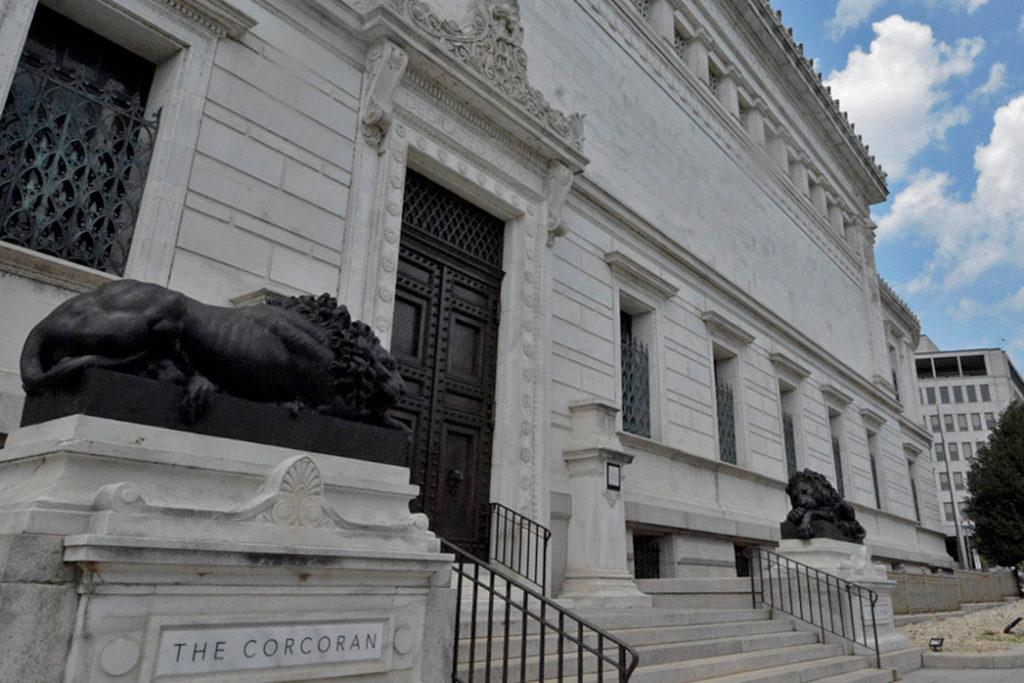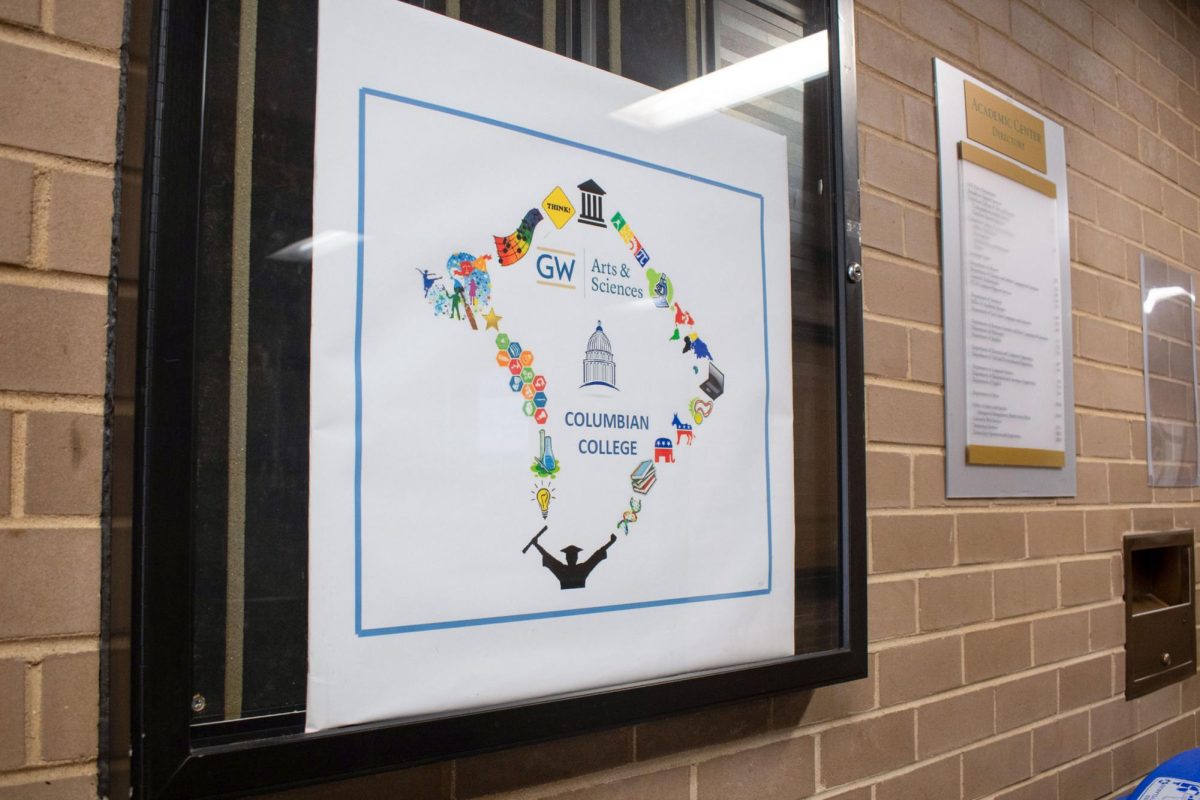Corcoran School of Arts and Design faculty are planning to continue incorporating digital aspects into the school’s academic programming as in-person classes resume this week.
Officials provided select students with campus access this past academic year to studio spaces and classes with in-person components, like outdoor art exhibitions throughout the Foggy Bottom Campus this spring despite the ongoing COVID-19 pandemic. Corcoran faculty said they did their best to adjust to teaching art classes online, and they anticipate incorporating more online offerings and shows within in-person classes in the future.
Kym Rice, the deputy director of the Corcoran School, said students and faculty reimagined how to teach and produce art in “radical ways” as classes were held virtually. She said professors teaching dance and animation classes brought in choreographers and animators from different parts of the world to speak to their classes and some faculty turned their homes into studios to accommodate online instruction.
“Many professional designers have to learn how to create a studio anywhere – be it a laptop on a make-shift desk,” she said. “For many students, the boundaries of domestic and professional lives were already blurred before having started to work freelance from their dining tables. The points of view are changing, and with that should our perspectives about studios.”
Rice said the school allowed about 100 students – mostly graduating seniors in select programs – access to studio space on campus last year so they could finish and present their theses and capstone projects during the pandemic.
Rice said students will present their work both in person and online next spring as Corcoran administrators anticipate offering more virtual events to reach people who can’t attend physical shows. She said Corcoran professors are also considering new additions to their classes, like hosting online speakers and using more eco-friendly materials and water-based inks that are safe for home use.
She said the Corcoran School’s end-of-year event called NEXT, where students’ projects and works go on display, was held virtually this past spring, but the online format allowed the event to reach “new” audiences.
Rice said the event’s virtual presentation included papers, photo essays, films, performance videos and paintings on disciplines like interior architecture, dance and theater. She said the only in-person portion of NEXT last spring included outdoor art exhibitions on campus that displayed students’ photos and artwork, lasting from late April to May.
“All of the NEXT presentations, whether on the website or visited in person, required a superhuman effort from Corcoran’s student participants, faculty and thesis advisers and the diligent work of our staff and creative partners,” she said.
Allyson Vieira, an assistant professor and coordinator of foundations in studio arts, said she was surprised to find that her students remained engaged in online discussions and benefitted from rewatching class recordings, a tool she hopes to continue using in the future.
She said art classes, like sculpture, wheel throwing and woodworking, are “reliant” on in-person instruction because they require equipment access and hands-on guidance.
She said the Corcoran community tried its best to adjust to virtual instruction this past year, canceling some required classes like the first-year studio foundations course because of the difficulties of teaching studio art online. She said the Corcoran School is offering five in-person sections of this course this fall instead of the normal three prior to the pandemic.
“If a student takes this class and completes this class, but they do it online, will it not even be remotely a close equivalent?” she said. “We want to make sure our students, when they leave GW and when they’re at GW, that they acquire the real skills that they need to succeed at the Corcoran and then after the Corcoran.”
She said some of her graduating seniors this past spring worked on in-person exhibitions across campus in the Smith Hall of Art and the University Student Center, constructing makeshift walls to hang and display their projects. She said these on-campus exhibitions, which they installed near the end of last semester as a part of their thesis show, gave students’ artwork greater visibility and increased the community’s access to art, which “went quiet” during the pandemic.
“The department fought really, really hard to make this happen,” she said. “And one of the greatest parts was when I did go on campus for the last couple weeks, I got to meet my students for the first time ever and that was a really special moment.”
Matt Eich, an assistant professor of photojournalism, said the past academic year was “tough” for Corcoran students and faculty because artmaking is more difficult to replicate over a screen, noting how printing requires “in-classroom experience.” Eich said he will host more virtual guests as a means of connecting students to a diverse array of artists and professionals to learn from and develop relationships with as a positive aspect of virtual instruction.
“There is almost always a silver lining if you look hard enough,” he said in an email. “I found it incredibly exciting to see what students were capable of producing in their home environments. It made space for a lot of very personal, introspective work, and I am very proud of what the students created.”
Arielle Bader, a photojournalism major and a recent graduate, said she lived in the District in the spring and took advantage of Corcoran’s in-person spaces, like the digital lab with printers and senior studios. She said she still would have preferred some classes to have been held in person because some courses, like printmaking, required her to have materials shipped to her apartment.
“I made it work as best as they could, but it definitely got more tiring virtually,” she said. “When you have a few hours to work on your project in person, it’s way more enjoyable because you can chat with your classmates. But over Zoom, all of us were just kind of alone in our own makeshift studios, working and didn’t really get to know each other too well.”
Bader, a former Hatchet photo editor, said she participated in the outdoor art exhibitions on campus for NEXT 2021, where her photos were on display at the Smith Hall of Art this past spring. She said she was satisfied with the on-campus experience since it was a “positive change” after a year of online classes, and she hopes for these kinds of opportunities to continue for future students.
“I definitely think in this situation, all the students were very thankful for the professors for putting a lot of time and work into making the virtual classes the best they could,” she said.








